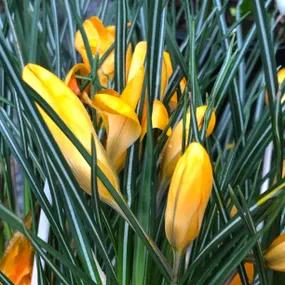'Yellow Mammoth' Crocus Bulbs
Honest Delivery Prices- Height: 4-5 inches tall.
- Colour: Yellow
- Flowering: Feb/March/April
- Scented
- Planting Depth: Twice the height of the bulb
- Bulb size: 8/9cms
Recommended extras
Description
Crocus vernus 'Yellow Mammoth'
For an early spring display of impressive colour year after year, we highly recommend these Crocus vernus bulbs (or Dutch Crocuses, as they are more commonly known).
Not only is the Crocus vernus the largest Crocus variety, but it is also one of the hardiest.
Yellow Mammoth by name, Yellow Mammoth by nature
This Crocus variety will not disappoint. As its name suggests, planting this Crocus will bring a much needed burst of sunshine to your early spring garden with its bright golden flowers. See the full range of crocus bulbs we have available for sale.
- Plant height: 4-5 inches tall. Although only a couple of inches taller than the Crocus Chrysanthus variety or Snow Crocus, it is often referred to as the Giant Crocus.
- Large single cup shaped flowers sit on top of slender stems with elegant long green leaves that resemble thick blades of grass.
- Flowers are a deep violet-blue.
- Scented, although this is only apparent at ground level.
- Plant in autumn in well-drained soil, in full or partly shaded areas. Will tolerate clay or loamy soil, as long as it is well drained, so be sure to add a generous helping of grit to soil before planting in such conditions.
- To give bulbs the best start in life, add a little bulb food at this stage too.
- Plant bulbs, or corms as they are called, about 3-4" deep and 3-4" apart.
- Water regularly throughout the autumn and also in winter and spring, in the absence of snow fall. During the summer season, they will happily lie dormant in drier soil conditions.
- Flowers from March to April, but in milder winters, blooming can start as early as February.
- It is important to note that Crocuses can be vulnerable to viruses, causing problems such as deformations and buds that don't open. There are no cures so it is imperative to get rid of infected plants to stop the virus spreading further.
- Bulb size: 3.5 inches.
For a natural look when planting in lawns or grassy areas, simply throw handfuls of the bulbs onto the ground and plant them where they land. A warning here, to lawn mowing enthusiasts – once blooming has finished, it is vital NOT to cut the grass for six weeks afterwards, in order to encourage self-seeding. Lift the corms every four to five years to divide and replant.
The bees absolutely love Crocuses, and being one of the first flowers of spring, they provide an invaluable food source for bees and other insects.
And finally...
This variety is probably the same as Crocus × luteus 'Golden Yellow', although we have yet to verify that for sure.
The first records of Crocus cultivation came from the island of Crete in Roman times. It wasn't until the 1560s that the first Crocus was seen in the Netherlands, when Crocus corms were brought back from Constantinople by the Holy Roman Emperor's ambassador to the Sublime Porte.
Crocuses are members of the Iris (Iridaceae) family and the word Crocus comes from the Greek name 'krokos' meaning saffron. However, there is only one species of Crocus that provides Saffron, the Crocus Sativus, which flowers in the autumn with large purple flowers and orange stigmas. Adding the stigmas, or saffron, to fish dishes is a must try, it is delicious!
Our Potted Bulbs A 1 litre pot contains approximately:- 10 small bulbs: anemones, crocus, dwarf daffodils, iris reticulata etc or
- 5 large bulbs: hyacinths, daffodils, tulips

 Hero Img.webp)
 Hero Img.webp)
